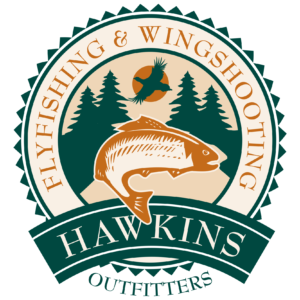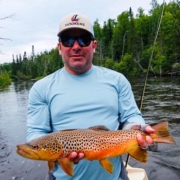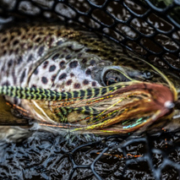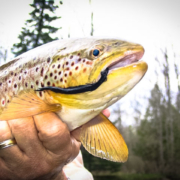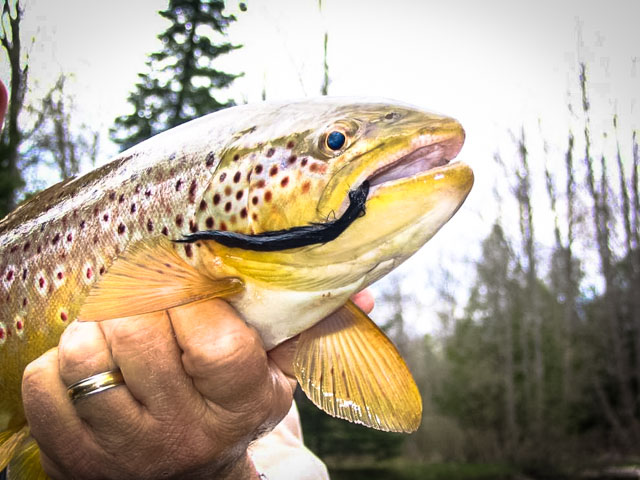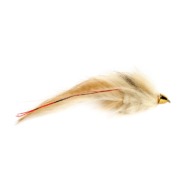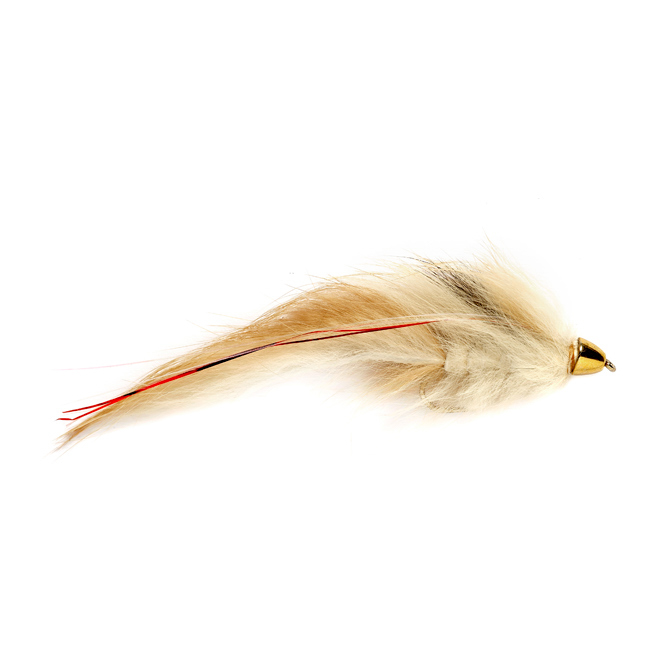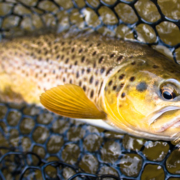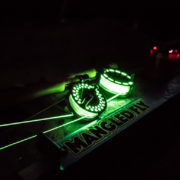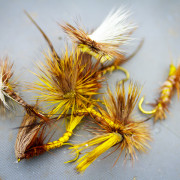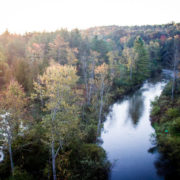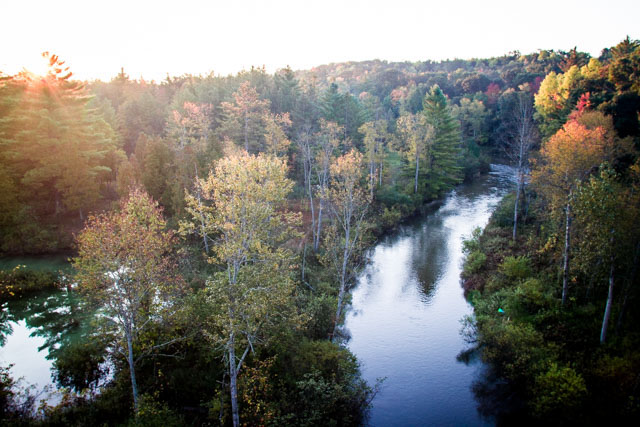Early Season Trout Fishing
When winter breaks and water temperatures start to warm it’s time to consider early season trout fishing.
Many anglers would ask, why? They are steelhead in our rivers that will probably bite better than resident brown and brook trout. The reason is that if you are a big trout hunter early season provides one of the best opportunities of the year to score on a big ole wiley brown trout.
Why Now?
There are several reasons that I think Early Season Trout Fishing provides one of the very best opportunities to land a significant trout in Michigan.
As the water temperatures increases so does the trouts metabolism. The urge to feed combined with the lack of insect activity creates an opportunity for an early season fisherman.
The fish haven’t seen a lot of angler pressure since fall. That makes them a little less wary and making mistakes more likely.
Water is usually still little high from spring runoff and will most likely still have more color. Makes it easier to pull bigger trout out of cover.
All of these reasons plus the lack of angler pressure and my motivation to get out and fly cast to resident fish makes this one of my favorite seasons in Michigan.
Water Temperatures
Water temperatures play a big role in early season trout fishing.
When the temps are below 40 degrees we don’t usually see the biggest browns but we do get those mid to upper teen fish that always make for a good day.
When the temps go above 40 degrees, this time of year will often produce a few really big fish for those willing to go on the hunt.
Once the water hits 40 degrees I’m looking for those big game anglers that can take the risk and go hunt those browns that we never forget.
How to early season trout fish in Michigan
Here are three tactics you can use for early season trout fishing success.
Streamers
First and foremost the best method for early season success is streamer fishing. Streamers are a great tool for searching out and engaging aggressive fish. After a long cold winter trout will be on the search for food even while water temps are still on the cold side. Look for trout to sit in areas with darker bottoms trying to absorb any sort of thermal relief from their surroundings.
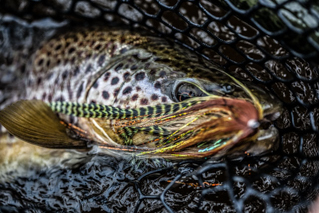
Streamer Fishing for Brown Trout
It’s not uncommon for trout so sit in really shallow water during the colder periods of the day. So if your wading or using a drift boat, make sure to pay attention to the bottom. We have seen trout in less than a foot of water on several occasions.
Chasing early season trout with a streamer is not a numbers game and we usually don’t find a lot of giants early either, but a common trout at this time on the Upper Manistee is 14-18”. It seems as this size class of trout is the most active during the early season. Make sure to have a combination of conehead or dumbbell streamer patterns and fish them with a slow jigging action around structure. The Hawkins Little Racal is a great place to start.
Dry Fly
While one of the hardest methods during the early season is Dry Fly fishing, it can be possible and very rewarding. With the largest BWO hatches of the season occurring in the early spring, along with little black stones and plenty of midges, there is always a chance of some trout surface activity on any given day the bugs show up. Now midges work best in the tailwaters like below Tippy Dam. You can have a fun few hours in the afternoon midging for trout on bright sunny days on tailwater sections or on a cloudy day when the BWO hatches show up in numbers.
Normally during the Early Season we carry two separate rods, one rigged with my streamer set up and one with an Floating Line set up. As we are drifting down the river, look for bug activity on the water and active fish feeding. On most days during the early season it is typical to only see a few heads rising per day within very short windows of activity on the surface. But if you capitalize on your opportunities it can be great fun.
The little black stone is probably my favorite early season bug. The Stonefly loves to lay it’s eggs in a fluttering almost tantalizing manner. Flying just above waters surface and even in the film of the current, the little black stones can cause some pretty explosive eats by trout. This doesn’t happen every day, but having the rod rigged and ready for action has brought a few nice early season trout to hand.
Nymphing
This little dirty word doesn’t come up too many times when you think about trout fishing in Michigan, but spring time can be a great time to get out the nymphing gear. If I have to be honest here, nymphing is not in our every day program and while we tend to push the nymphing game on our migratory streams, nymphing for trout is often ignored. Nymphing for trout behind
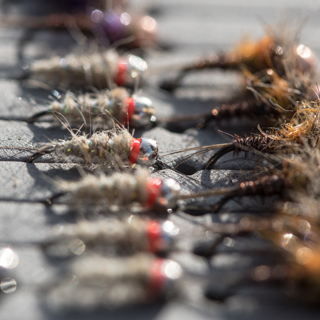
Trout Nymphs
spawning steelhead or spawning suckers can be great fun. With Spring Steelhead in the peak of their spawning run trout will gorge on eggs and dislodged nymphs behind active spawning areas. While we are big on letting steelhead spawn, fishing the dark water for trout can be very productive, especially on the Pere Marquette River where this has been a staple of the spring program for years.
Now if your thinking about nymphing for trout above the tailwater’s be ready to lose a few nymphs to all the wood that lines our Northern Michigan trout streams. With the amount of wood around keep your nymphs selection simple. Don’t spend lots of time either tying or buying elaborate nymph imitations. Instead try running nymphs like Pat’s Rubber Legs and smaller Squirmy Worms, espically in tandem with a small bead head pheasant tail or hares ear and you will do just fine.
When trout are not chasing streamers or conditions are not right for the bugs to hatch, trout will have to eat something. Nymphing the runs can be the most productive technique for the utterly slow times on the water. Here is an early season trout tip: while nymphing, focus on the gravel areas more than the deep sandy pits as aquatic life in the gravel runs is more active earlier in the season.
Where
Many of our best rivers like the Manistee, Pere Marquette and AuSable River’s are open all year so that’s a good place to start. A favorite of mine is to hunt big trout with streamers in water that also has steelhead present like the Manistee River below Tippy Dam. That gives you two bites of the apple because steelhead, especially drop backs, will eat streamers. Many times I’ve scored both on big browns and steelhead fishing streamers in the same day.
If you are motivated to get out and cast a fly line and looking for some excitement give Cherie a call at 231-228-7135. I’m sure any of the Hawkins guides would love to chase trophies with you.
Tight lines,
Capt. Chuck Hawkins

